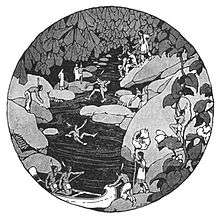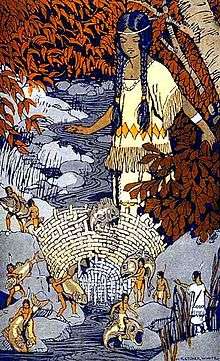Little people (mythology)
Little people have been part of the folklore of many cultures in human history, including Ireland, Greece, the Philippines, the Hawaiian Islands, New Zealand, Flores Island, Indonesia, and Native Americans.

Native American folklore
The Native peoples of North America told legends of a race of "little people" who lived in the woods near sandy hills and sometimes near rocks located along large bodies of water, such as the Great Lakes. Often described as "hairy-faced dwarfs" in stories, petroglyph illustrations show them with horns on their head and traveling in a group of 5 to 7 per canoe.[1]

Native legends often talk of the little people playing pranks on people, such as singing and then hiding when an inquisitive person searches for the music. It is often said that the little people love children and would take them away from bad or abusive parents or if the child was without parents and left in the woods to fend for themselves.
Other legends say the little people if seen by an adult human would beg them not to say anything of their existence and would reward those who kept their word by helping them and their family out in times of need. From tribe to tribe there are variations of what the little people's mannerisms were like, and whether they were good or evil may be different.
One of the common beliefs is that the little people create distractions to cause mischief. They were believed to be gods by some. One North American Native tribe believed that they lived in nearby caves. The caves were never entered for fear of disturbing the little people.
Legends of physical remains of tiny people being found in various locations in the western United States, particularly Montana and Wyoming, typically describe the remains as being found in caves with various details such as descriptions that they were "perfectly formed", dwarf-size, etc. Archeologist Lawrence L. Loendorf notes that "The burials, of course, are always sent to a local university or to the Smithsonian for analysis, only to have both the specimens and research results disappear."[2] Loendorf also suggests that the discovery of two mummies of anencephalic infants in the first half of the twentieth century with deformities that caused some people to believe they were adults has "contributed to public belief in the existence of a group of tiny prehistoric people."[3]
A graveyard unearthed in the 1830s in Coshocton County, Ohio, was believed to contain skeletons belonging to a pygmy race. In fact, the graves (which were roughly 3 feet (0.91 m) long) were "bone burials" containing disarticulated or bent bones packed together.[4]
Native American little people
- Chaneque - Aztec
- Geow-lud-mo-sis-eg - Maliseet[5]
- Ircinraq - Yup'ik
- Ishigaq - Inuit
- Jogahoh - Iroquois[6]
- Mannegishi - Cree
- Memegwesi/Memegawensi/Memengweshii/Pa'iins - Anishinaabe[7]
- Nimerigar - Shoshone
- Nirumbee[8] or Awwakkulé[9] - Crow
- Nunnupi - Comanche
- Pukwudgie - Wampanoag
- Yehasuri - Catawba
- Yunwi Tsundi - Cherokee
- Canotila - Lakota[10]
- Popo-li or Kowi Anukasha - Choctaw[11]
The Native American little people have been said to reside in the Pryor Mountains of Montana and Wyoming. The Pryors are famous for their "fairy rings" and strange happenings. Some members of the Crow tribe consider the little people to be sacred ancestors and require leaving an offering for them upon entry to the area.[12]

Memegwaans
Ojibwe myths also bring up a creature known as the Memegwaans, or Memegwaanswag (Plural), which seems to be different from the more common Little People variation of Memegwesi. According to Basil H. Johnston, a Memegwaans is a little person without definitive form which is terrified of adult humans. However, it seems to have a soft spot for children and will often approach in the guise of a child any young person who seems upset, injured, scared or lonely and either protect them or keep them company until help arrives. If an adult sees one, they will often cower on the ground, screaming and crying hysterically before vanishing in the blink of an eye. They were also known as protectors of copper mines & were prayed to almost as patron saints of lost children. This is more specific & different from the Memegwesi, which is often simply described as a short, hairy man.[13]
Types of little people in mythology
- Brownies / Tomte / Tonttu / Domovoi / Kobolds / Zlydzens
- Christmas Elves
- Dwarves
- Di sma undar jordi
- Gnomes
- Karzełek
- Knocker
- Nimerigar
- Goblins / Gremlins
- Laminak
- Tylwyth Teg
- Leprechauns
- Pixies
- Sprites
- Taotao Mona
- Menehune
- Trows
- Pygmies (in Greek mythology)
- Abatwa (only partly mythical, see Twa for historical background)
- Ebu Gogo (Flores)
- Nittaewo (Sri Lanka)
- Ta'ai, or 小黑人 - in the mythology of, or remembered by, the Saisiyat people of Taiwan
- Patupaiarehe (in New Zealand Maori mythology)
- Qutrub
- Trauco - Chilote mythology
- Pombero - Guarani mythology
Types of little people in fictional mythologies
- Hobbits / Halflings / Kenders
- Tcho-Tcho
- Lilliputian
Little people in literature
References
- Furtman, Michael. 2000. Magic on the Rocks. Birch Portage Press.
- Loendorf, Lawrence L.; Nancy Medaris Stone (2006). Mountain Spirit: The Sheep Eater Indians of Yellowstone. University of Utah Press. p. 90. ISBN 978-0874808681.
- Loendorf, Lawrence L.; Nancy Medaris Stone (2006). Mountain Spirit: The Sheep Eater Indians of Yellowstone. University of Utah Press. p. 189. ISBN 978-0874808681.
- Squier, Ephraim George (1984) [1849]. Aboriginal Monuments of New York. Sourcebook Project. p. 130. ISBN 978-0915554157.
- Paul, Pat (1996). "Little People Geow-lud-mo-sis-eg". Retrieved 2020-08-13.
- Stories the Iroquois Tell Their Children
- Freelang Ojibwe Dictionary
- Daniels and Stevens, Encyclopaedia of Superstitions, Folklore, and the Occult Sciences of the World, 1903, p. 1421.
- Frey, The World of the Crow Indians: As Driftwood Lodges, 1993, p. 68.
- Walker, James R. "Lakota Myth". 1896
- -
- Cheung, Theresa. 2006. The Element Encyclopedia of the Psychic World. Harper Element.
- Johnson, Basil "The Manitous: The Spiritual World of the Ojibway". 1996
Bibliography
- Daniels, Cora Linn and Stevens, C.M. Encyclopaedia of Superstitions, Folklore, and the Occult Sciences of the World. Milwaukee, Wisc.: J. H. Tewdai & Sons, 1903.
- Frey, Rodney. The World of the Crow Indians: As Driftwood Lodges. Norman, Okla.: University of Oklahoma Press, 1993.
| Wikimedia Commons has media related to Small humanoids. |